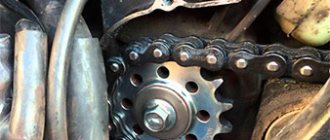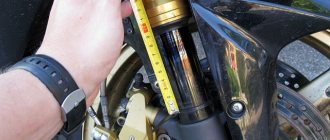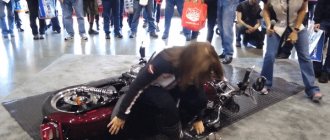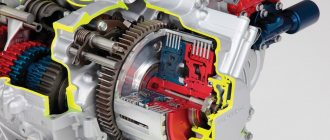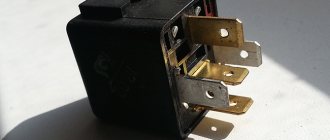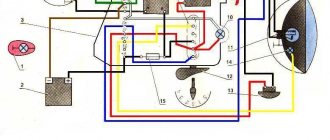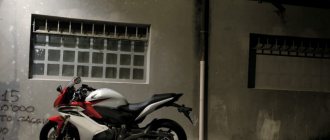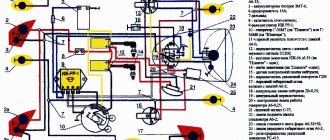Pleasant advantages
The engine itself is not demanding in operation; it produces power up to 20 horsepower. It is refilled, like most representatives of this model range, with a gasoline-oil mixture, ensuring good treatment of the piston group and bearings.
The Izh Planet-5 motorcycle has a small fuel tank, only 17 liters , but this does not increase its appetite. Consumption in the city for every hundred kilometers is equal to four liters, and on the highway at maximum acceleration, all five.
The oncoming flow perfectly cools the engine, protecting it from overheating. At the front there is a standard telescopic fork with two shock absorbers. At the rear, the pendulum suspension is also equipped with a pair of shock-absorbing mechanisms.
Front brakes are manual, rear brakes are foot controlled, the brake itself is shoe brake. In the photo of Izh Planet-5, small eighteen-inch wheels are clearly visible, and the design itself is quite light and does not reach two hundredweight.
Back in the USSR. Test drive of the fastest Soviet motorcycle
“Izh Planeta-Sport” is perhaps the most unusual Soviet motorcycle. All the boys in the USSR dreamed about him. He was like a breath of freedom - modern, bright, fast... And sporty. Because he was often included in road accident reports, he was even called “Izh Planet-Death”. Yuri Gladchuk rode the legendary vehicle, risking his life.
Rock and roll in its purest form
I'm back in the USSR, you don't know how lucky you are, boys. Back in the USSR.
To understand this motorcycle, you need to play the famous Beatles song “Back in the USSR”. Because “Izh Planeta-Sport” is rock and roll in its purest form. Do not read this text without playing this music in the background. Have you turned it on? Then let's go!
Today, the decaying capitalist technologies of GoPro allow you to return to the former USSR - they filmed for you an atmospheric trip through the village on “Sport” from the first person
I don’t know what it was like in the 70s and 80s, because I was born in the last years of the Soviet Union, but I think everything was great. It was especially great for those who for a long, long time under Back in the USSR dreamed of the fastest Soviet motorcycle, and then realized their dream. And if you also had jeans with your Izhu, that’s it, you’re the first guy in the village. Although girls should “get along” with “Planet-Sport”, as the old Soviet advertising clearly hinted at. And she was right.
Beautiful motorcycle. It is completely incomprehensible how the ideological department of the party allowed him to be released. After all, it is obvious that it was created for dudes, parasites and other hooligans. Lovers of jazz and rock and roll. But they said that if you listen to jazz, it means you’ll sell your homeland.
Five interesting facts about Izh Planeta-Sport
1. When production began, the motorcycle cost about 1,050 rubles, subsequent batches began to be sold for 1,000 rubles, so not every parasite could afford it. Moreover, in those years, Moskvich-412 cost about 5,000 rubles.
2. Soviet motorcyclists gave the motorcycle the nickname “dog” (from the abbreviated “Izh PS”), “peeska” and “sportak”.
3. Due to the unusually high quality, it was rumored that Planet-Sport was intended for export to the USA. It was indeed exported and was especially loved by motorcyclists in the UK, the Netherlands and Finland.
4. “Sports” were bright yellow and orange, which, combined with the black color of the frame and the strict shine of nickel-plated parts, looked truly sporty.
5. “Izh Planeta-Sport” withstood 50-60 thousand km without noticeable wear of the main components. Very good for Soviet motorcycles.
There are legends that they allegedly complained about this motorcycle to the main ideologist of the party, Mikhail Suslov, and he tried to ban its sale. But the production of “Sport” was approved by Brezhnev, who personally rode a motorcycle. Rumor has it that Leonid Ilyich himself loved driving fast, which is probably why Izh Planeta-Sport went on sale. It’s not a fact that everything really happened like that, but the motorcycle really turned out to be hooligan.
Externally, the “dog” was very similar to Japanese motorcycles of the mid-1960s such as the Suzuki T250 Super Six, Yamaha 350R5 and Kawasaki A1 Samurai. It suited the hipsters because it was truly stylish. Look at the black round trim on the tank! The swift, light silhouette of the motorcycle immediately made it clear that the device was not intended for transporting potatoes, but for high-speed “annealing.” Even these days, when retro themes are popular in customization, “peeska” looks cool.
Before the advent of Planet-Sport in 1974, hooligans, parasites and dudes drove Czech Jawa. But the “dog” immediately pushed the “Czechs” into second place. Compared to its direct competitor Jawa 350-634, the new Izh accelerated and braked better, and had a higher maximum speed. Still, the weight was less and the horsepower was greater. Again, style, style and more style. Although there were fierce debates between fans of “javas” and “dogs” about whose motorcycle is cooler, I prefer the “Izh” - it has more rock and roll!
Damaging ties with the West
You approach the motorcycle and you are surprised. Labels for buttons on remote controls and light bulbs are in a foreign language! When you lean towards the carburetor, you see the magic word JAPAN. The vast majority of inscriptions are not in Russian, but in English. Can you imagine how cool that was at the time? There is even an emergency engine shutdown button and a light that lights up when you find “neutral.” Moreover, all the buttons are located the same as on any modern motorcycle - the remote controls are Japanese.
And this is not a “collective farm”. Early motorcycles were standardly equipped with Japanese electrical equipment, optics and a carburetor. Some parts were supplied from European motorcycles, for example, the first Izhas had a Czech ignition switch and an Italian speedometer. Even the battery was imported at first.
And the early “Planet-Sport” had a separate lubrication system. Typically, two-stroke engines are lubricated with oil, which is mixed with fuel in one ratio or another. Therefore, the amount of oil entering the engine depends only on the amount of gasoline supplied. But the early Peeski had a pump, the performance of which increased with increasing speed or load on the engine.
Memoirs of one owner of Izh Planet-Sport (taken from here)
“Excessive thrust-to-weight ratio allowed the Sport to easily stand on the rear wheel, which I often used in front of bored young ladies. And one day this trick acquired a special chic. I deliberately removed the seat belt so that the passengers would hug the driver more tightly and sensually. My comrade, who turned out to be a passenger, sat carelessly in the back and didn’t try to hug me at all - I didn’t mind. Having stopped near the girls, we casually greeted them, and I unscrew the gas handle, throwing the clutch.
The front wheel comes off normally - the motorcycle “shoots” almost beyond the horizon. I slow down, look around - and am horrified: my friend, with clouds of dust on his hands and knees, continues his fading movement behind me! There were holes in the jeans and sleeves, there was blood in the knees and elbows... But the friend was an optimist, and a drunken optimist, so they agreed to consider the sketch staged, and the performance in front of the public as successful. He didn’t ride as a passenger anymore, he began to respectfully call “Sport” “peas”, and he started calling me “mad,” especially after racing along the platform and steps of the railway station.”
Over time, Izh Planeta-Sport lost both imported components and the separate lubrication system. Due to the replacement of the Mikuni carburetor with the domestic K-62M, the maximum power decreased from 32 to 28 hp. Therefore, motorcycles from the first years of production, which had all this, were especially valued. And the early “dogs” were expensive even at the age of ten. A more detailed history of changes in the technical part can be read here.
For example, our guest is a perfectly preserved motorcycle from 1978. with a mileage of only 15,000 km and in “original” paint. The previous owner himself changed the carburetor from Soviet to Japanese. The rear light is already Soviet. But the turn signals, headlights and remote controls are imported. There is no longer a separate lubrication system, just as there are no rubber engine mounts of early copies. Not the same pie, of course, but still a very cool motorcycle. Why? Now let's start it up and tell you.
Triple purpose motorcycle
You'll do some magic with your paw, start this miracle motorcycle, and you'll smile from ear to ear. Even for me, whose childhood was spent in the 90s, nostalgia mode turns on, because the sound of a two-stroke engine is the sound of my childhood!
Rumor has it that starting it was not as easy as its Czech competitor. Yes, there is such a nuance, especially when it’s “cold”. You will also get feedback from the “kick”, tea, not a modern electric starter. But when you start it, your pants are full of delight!
For the USSR of that time, this was a very fast motorcycle. The 340cc “single-barrel” two-stroke originates from motocross bikes, so it turns easily, “explodes” at mid-range speeds and rides happily at the “top”. Despite its age, it quickly reached 120 km/h, with some room left to accelerate to the official 140 km/h.
Yes, according to the passport, the Peeska reaches “hundred” in 11 seconds, but subjectively the motorcycle accelerates faster. In the conditions of modern city traffic, you will definitely be the first among the cars. On the highway, 100-110 km/h goes without much “strain”, except that the wind blows away both the motorcycle (the light weight affects it) and the motorcyclist (there is no windshield). But I don’t see anything bad in this - everything together adds a sharpness to the sensations.
If you mentally transport yourself on it to the Soviet Union of the 1970s, remember what kind of equipment Soviet people used to move around, then you understand that “Izh Planet-Sport” is really “Izh Planet-Death”. Too much dope and too little weight: Shaitan-arba, not a motorcycle!
At the same time, there is really no equipment, there are few good roads, not all cars have scanty mirrors, and if they do, it is only on the left. It’s good that there were many fewer of these cars than there are today. But in any case, the Izh Planet-Sport is a deadly fast motorcycle for the Soviet Union.
But in modern times, 32 forces is nothing. Modern sportbikes have become “fat” and have become many times more powerful, so the lightweight Izh feels like a bicycle compared to them. It is very easy to operate. At low speeds there is no light, of course, but the motorcycle moves - even a beginner can get on.
The seat is comfortable: the seat is straight - everything is just right. The only thing is that it’s not very convenient to press such a thin tank with your knees, but this is a matter of habit. Also, all Soviet motorcyclists unanimously complained about vibrations, saying that there were none in Jawa. But I often ride “single-barrel” vehicles, so I didn’t feel much discomfort.
Brakes? They are a little bit - that's all I can say about them. The rear one is still something, but the front one needs to be pressed with all your might. Gear shifts are not the clearest. But I compare it with modern technology, and for those times everything was good with the brakes and gear shifting.
Today you are surprised by something else - versatility. And in the city you can show off with it, and you drive quickly on asphalt, and in the absence of roads there are no problems. Light weight, short first gear, strong fork, short wheelbase - easy to ride even on rough terrain. Yes, the rear suspension is a bit stiff, the clearance is small - after all, this is far from a modern enduro. But at one time, in the fields and forests at Planet-Sport, they had a blast!
At the same time, you drive over bumps, you drive fast, but nothing rattles or falls off, as in some modern “Chinese” cars. In general, there are no extraneous sounds in the pits. None. “Izh” does not “walk” under you, it feels solid and solid. In general, for Soviet technology this is a very high-quality motorcycle.
“Izh Planeta-Sport” is not only a dual-purpose, but a triple-purpose motorcycle!
1. “To show off.” I put on jeans, got on a fashionable bike, went to a country club - all Masha is yours. The main thing is not to knock on the helmet, which is flimsy in appearance and touch - they never liked “majors”.
2. Good on asphalt. Considering the dynamic characteristics of cars and motorcycles of the USSR, “Izh Planeta-Sport” compared to them is the most sportbike.
3. The motocross heritage of the Izh-55 is felt in the motorcycle - it is not afraid of rough terrain. This is also facilitated by the very low weight - only 135 kg of “dry” mass. On the basis of Planet-Sport, in April 1975, the production of sports motorcycles for the multi-day enduro “Izh M-15” and the cross modification “Izh-K-15” began.
But the music did not play for long - in 1985 the motorcycle was discontinued. Why it was removed is unclear. Some say that due to low demand, they say, the quality has become lower, but the price has remained the same, others refer to the high mortality rate of pilots, and others - to the fact that the State Traffic Inspectorate could not catch up. Tales and legends have always surrounded this motorcycle.
Who wants Back in the USSR, today this can be done with the help of the Izh Planeta-Sport time machine - they still appear in advertisements. Mix gasoline with oil, start it with your paw, and start it the first time - and into the field, at sunset, inhaling the aroma of summer deeply.
What could be better? There's nothing better.
Yuri GLADCHUK Photo and video of Anton SHELKOVICH ABW.BY
The editors thank Nikolai Melnikov for providing Izh Planeta-Sport for the test
Notes in the margins
Everything is progressive in the Planet-Sport, but there is no side step. For some reason, the “eye” of the central footrest is on the right side.
For a Soviet motorcycle there are a lot of light bulbs. All inscriptions are in a foreign language. As a child, it was of great importance what speed the speedometer of a particular type of transport was lined up to. In Planet-Sport everything is fair: the speedometer shows a maximum of 140 km/h - the motorcycle goes 140 km/h. For beginner motorcyclists, it is clearly indicated at what speed to change the next gear.
The only Russian inscription visible on the motorcycle is “Izh”, everything else is in English, including the model name PLANETA-SPORT 350.
The sides are unscrewed with a simple “twist”; the saddle, under which there was a scarce imported battery, was not locked. Steering wheel locking only appeared at the end of 1978. Before that, take it - I don’t want it.
The bike has an on-board 12-volt power supply. The Czech competitor at that time could only boast 6 volts.
The official range is 400 km, which is very good. I haven't actually tested it. The tank volume is 14 liters, while fuel consumption is documented to range from 3.5 to 6.5 liters, depending on speed and driving style.
Different sized wheels (19 inches front, 18 rear) and brake drums - this was very unusual at that time.
On this occasion, we invite you to the largest retromoto festival in Eastern Europe, “Kola Chasu”. Perhaps Planet-Sport will also come there - today it is a rare and exclusive motorcycle. In any case, about 200 pieces of rare equipment will be collected in one place - there will be something to see. And not just to look. The festival will have a recreation area, a food court, a running and cycling area for children, rental of catamarans and boats, a shooting range, a test drive of the M1NSK motorcycle and other entertainment. In addition, there will be an opportunity to purchase both antiques or even retro equipment, as well as modern motorcycles. So, the Rowing Canal on the Zaslavsky Reservoir, June 25. Come with the whole family - it will be interesting! More information about the festival can be found here.
Defining technical characteristics of Izh Planet-5
| Original dimensions (length/width/height) meter | 2,2/0,81/1,2 |
| Base dimensions, meter | 1,45 |
| Clearance height, cm | 13,5 |
| Engine characteristics | Capacity—346 cm3, power 22 horsepower, two-stroke for 1 cylinder, |
| Cooling system | Air |
| Transmission | Multi-disc clutch; 4-speed gearbox |
| Refueling | Oil-gasoline mixture |
| Fuel tank capacity | 18 liters |
| Permissible maximum speed for motorcycle "Izh Planeta-5" | 120 kilometers per hour |
| Fuel | Gasoline grade A-76 |
| Ignition mechanism | Contact battery; |
| Start | Kickstarter; |
| Electrics | 12 volt battery |
| Brake mechanism | Mechanical drum front and rear, linkage rear, telescopic front, hydraulics |
| Refilling shock absorbers (front/rear) volume per shock absorber | 0.175 liters/0.075 liters |
| Wheel sizes | 3.5x18 inches, knitting needles |
| Dry weight | 162 kilograms |
| Filled weight of the unit | 180 kilograms |
| Permissible load | 170 kilograms |
| Maximum at gross weight with trailer | 200 kilograms |
Multiple videos of Izh Planet-5 are “live” confirmation of the popularity of the cruiser, and with proper care, its durability. A huge advantage of a motorcycle is its ability to allow any tuning transformations .
Modernization of almost any spare part is painless, and the final result makes you feel genuine pride.
The qualitative characteristics of the motorcycle confirm its necessity and indispensability in suburban conditions.

